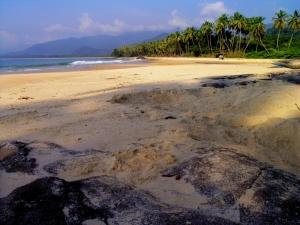Sierra Leone, Liberia, and Guinea have reported 85 new Ebola cases and 68 recent deaths, with the vast majority in Sierra Leone and Liberia, the World Health Organization (WHO) said in an update late yesterday.
The cases bring the total for the world’s largest and deadliest outbreak ever of Ebola virus disease (EVD) to 964 cases and 603 deaths, up from 888 cases and 539 deaths reported by the WHO just 4 days previously. (The number of previously reported deaths plus the number of new deaths don’t add up to the new fatality total because adjustments are continually being made about cause of death.) Both cases and deaths are more than double any previous EVD outbreak.
The latest cases were reported to the WHO from Jul 8 through Jul 12.
The EVD outbreak is the first confirmed in West Africa, though a new study demonstrated evidence that the disease was present in Sierra Leone as early as 2006.
New cases and deaths
Sierra Leone reported 49 new suspected, probable or lab-confirmed cases and 52 new deaths in the 5 days ending Jul 12. The country’s totals now stand at 386 cases and 194 deaths.
Liberia has had 30 new EBV cases and 13 new deaths in the same period, bringing its outbreak totals to 172 cases and 105 deaths.
The WHO said of the rate of new EBV cases in the two countries: “This trend indicates that a high level of transmission of the Ebola Virus continues to take place in the community.” In fact, if the outbreak continues to expand at current levels—a trend the WHO calls “serious”—Sierra Leone will soon overtake Guinea for highest case count.
Guinea reported 6 new cases from Jul 8 through 12, and 3 new deaths. The nation, which is where the outbreak began, now has 406 cases and 304 deaths.
The WHO did not list specific regions for any of the new cases, contrary to most previous reports.
The outbreak case-fatality rate (CFR) has reached 63%. The Zaire strain of Ebola virus that has caused the outbreak has been associated with a CFR as high as 90%.
WHO efforts in the region
WHO’s regional director is redeploying senior, technical, and support staff to a sub-regional center that opened today in Conakry, Guinea, the agency said in its update.
“The personnel re-assigned include a Director, Regional Advisors, epidemiologists, communication experts, social mobilization specialists, data managers, administrative officers, and other support staff,” the WHO said. The center is designed to coordinate response efforts and help mobilize resources.
The WHO is also helping the three affected countries update their national EVD response plans so they align with a regional strategy recently adopted by health ministers in the area.
“The operational plan will clearly highlight priority interventions and map out the required resources (human, financial, and logistics) for effective implementation of the outbreak containment measures,” the WHO said, “In addition, these documents will be vital for mobilization of the additional resources.”
The agency has also helped Liberia train 107 community volunteers and 33 supervisors to respond to the outbreak. And the WHO said it has assisted with the training of 296 volunteers in Sierra Leone to conduct contact tracing and help identify and evacuate suspected case-patients.
The WHO also said it has provided personal protective equipment for health workers in Liberia with support from the US government. It reiterated its recommendation to not limit trade or travel to the three countries.
Evidence of previous EVD in the region
In related news, about 9% of samples from patients who tested negative for Lassa fever in Sierra Leone had antibodies to EVD, indicating infection with the virus as early as 2006, according to a study in the current issue of Emerging Infectious Diseases.
The study was led by scientists with the US Army Medical Research Institute of Infectious Diseases (USAMRIID), which has been assisting with Ebola outbreak response since March.
From 500 to 700 clinical samples are submitted each year to the KGH Lassa Diagnostic Laboratory in Sierra Leone, and only 30% to 40% test positive for Lassa fever, a disease related to Ebola that also causes viral hemorrhagic fever (VHF). The team set out to determine which other viruses had caused Lassa-like illness in the region. They used enzyme-linked immunosorbent assay (ELISA) to detect immunoglobulin M.
Of samples from 253 patients submitted to the lab from 2006 through 2008, they found the prevalence of antibodies to Ebola and Marburg virus, another VHF-causing pathogen, to be 8.6% and 3.6% respectively.
The prevalence of antibodies to other viruses was: dengue, 4.3%; chikungunya, 4.0%; West Nile, 2.8%; yellow fever, 2.5%; and Rift Valley fever, 2.0%. All told, 25.7% of the patients originally suspected of having Lassa fever tested positive for antibodies to one of the eight viruses tested.
“Prior to the current outbreak, only one case of Ebola had ever been officially reported in this region, and it was from the Ivory Coast strain,” said lead author Randal J. Schoepp, PhD, of USAMRIID, in a USAMRIID news release posted yesterday. “We were surprised to see that Zaire—or a variant of Zaire—was causing infection in West Africa several years ago.”
If our reporting has informed or inspired you, please consider making a donation. Every contribution, no matter the size, empowers us to continue delivering accurate, engaging, and trustworthy science and medical news. Independent journalism requires time, effort, and resources—your support ensures we can keep uncovering the stories that matter most to you.
Join us in making knowledge accessible and impactful. Thank you for standing with us!

